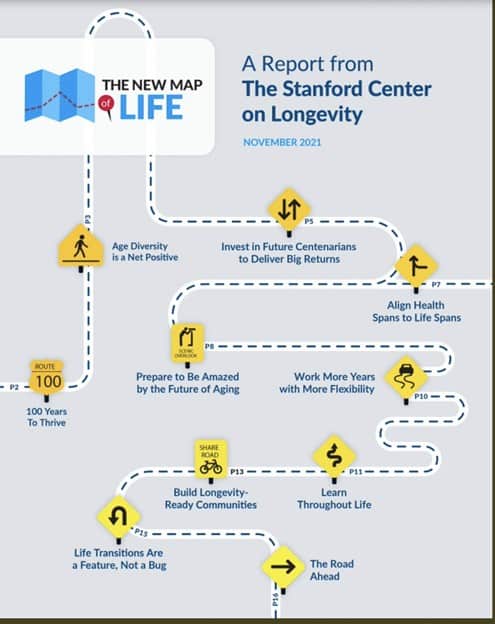
7 Longevity Areas Next Generations Will Need to Consider
You may have seen the report from the Stanford Center on Longevity titled the New Map of Life. It is written not only with longevity of us, the baby boomers, but more futuristically benefitting our grandchildren and great-grandchildren.

We are only the beginning of the expected 100-year-olds. Those grands and great-grands today have an even greater likelihood of hitting that 100-year mark.
This path created by the Center was developed by an interdisciplinary team of fellows and faculty in nine domains. The team has expertise in all the fields explored.
Here are the primary areas that the Center studied and offered recommendations for how society can benefit from longevity of the next generations.
Age Diversity as Net Positive
The increase in American families living in two- or three-generation homes is expected to increase. While part of this trend can be attributed to financial circumstances, multigenerational households can solidify family bonds and provide additional family members to assist with finances, childcare or continued educational opportunities for younger generations.
As well, we need to recognize the need for age diversity in the workforce and get rid of stereotypes of older workers. Currently, seniors continue to work in technical positions, and their reliability and competence benefit their employers and serve as an example to younger workers.
Investment in Future Centenarians
This report questions the wisdom of rushing students through high school and college and suggests that the concept of life-long learning be established early in education whether it occurs in or out of a classroom.
Children born now will have a much longer life to learn and be productive. The researchers also recommend early education development of a strong foundation of play, and creative and physical activities.
They point out that encouraging the early development of resilience and curiosity at an early age prepares children for the events, negative and positive, that can occur over a lifetime.
Health Spans = Life Spans
Health care coverage and access throughout the life span across the board for all communities will be essential for the coming generations. Some of the tools that have been implemented recently is the use of telemedicine.
Continued use can provide greater access but will also require broadband availability for rural and vulnerable communities. The same is true of smart wearable devices that can monitor health issues such as diabetes and some heart issues.
The Future of Aging
The Stanford Center expects even the five-year-olds of today to be amazed at their ability to remain mobile longer with transportation devices such as e-bikes that will be sensitive to the user’s capability. They also expect the area of geoscience to offer interventions to disease before advanced damage can occur. Later years for the now five-year old will likely be more vital and offer far more independence.
More Years of Work/Employment – Greater Flexibility
The inequities and issues in the work environment became clear during the pandemic. Our grands and great-grands will likely work more years but will have more flexibility.
Adequate childcare for the offspring of those now-children will be even more meaningful given the expected long work life. All of the above will need to be executed in the most profitable way for families and communities.
Tax changes, as well as changes to the way retirement, Social Security and Medicare are structured will need to be explored and reconfigured.
Learn Throughout Life
I feel like I, along with most of my friends, have continued to learn throughout my life and continue to do so. I think we have frequently referred to it as reinventing ourselves. As this paper suggests, reaching out in new areas of learning and new ways of thinking will become a natural part of a longer life span.
The Center makes a distinction between learning and education. They also find that two areas of challenge are the inequities in the existing formal education system and the creation of new paths to learning not so closely tied to that formal education system.
In this world of longevity, institutions will need to adapt to students who have varying background and ages as they transition in life at different times. A more open understanding of what trades, skills and apprenticeships are on offer for the benefit of society can exist as a more equal option to a college degree.
Longevity-Ready Communities
We could use this now. The next generations and their government(s) will need to seriously tackle climate change, as well as any threats to our air and water, the basic needs of those long lives. What kind of housing will families be demanding as multiple generations continue to be alive at the same time?
There is so much to consider in this report. I have barely hit the highlights and recommend reading the report in its entirety. It is clear and to the point and would be a pleasure to read if the issues didn’t seem so daunting.
An additional issue that comes to mind is the overcrowding of our planet as generations live longer. This is already an issue for some nations.
Let’s Have a Conversation:
Have you thought beyond our expanded life spans to those of our younger family members and friends? Do you agree with the points raised by the Stanford Center?






